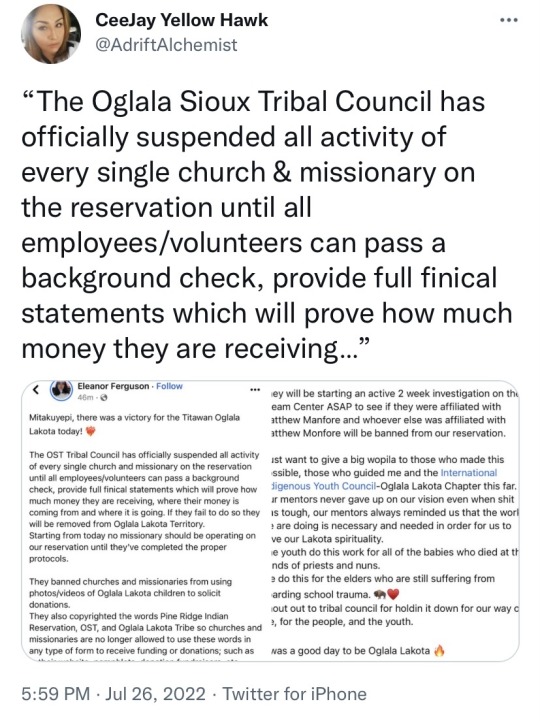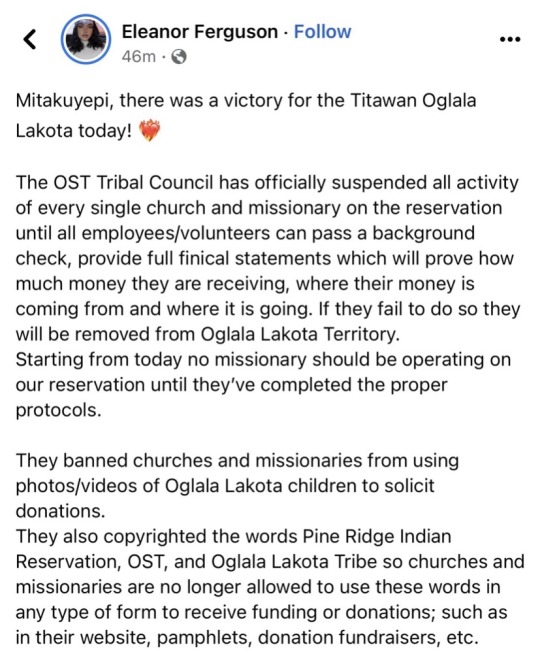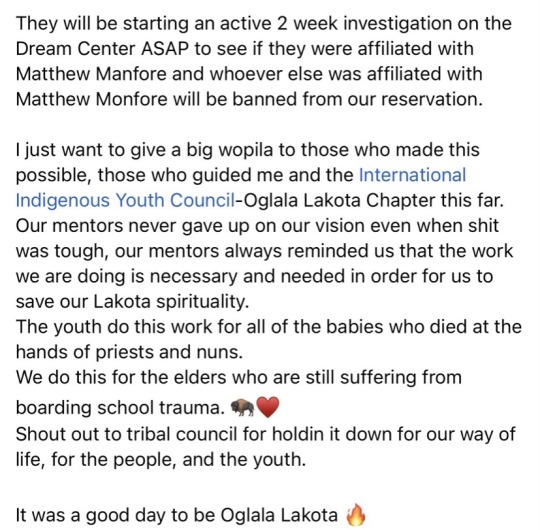Note: If you are looking for my personal blog, here is the link: somewhereoverbifrost.tumblr.com; I've been on a bit of a hiatus lately. I need to regroup a bit.
Don't wanna be here? Send us removal request.
Text
First Black Mayor of Alabama Town Locked Out of City Hall and Locked Out of Bank Accounts - White Resident Says Town Isn't Ready for Black Mayor - Town is 85% Black 🫠
youtube
5 notes
·
View notes
Link
Indigenous-led resistance to 21 fossil fuel projects in the U.S. and Canada over the past decade has stopped or delayed an amount of greenhouse gas pollution equivalent to at least one-quarter of annual U.S. and Canadian emissions.
This is despite an onslaught of attacks against Indigenous activists over the past few years. Over the last few years, victories won against projects through direct actions have led to more than 35 states enacting anti-protest laws, jail time for protestors, thousands of dollars of fines, and even the killing of prominent activists.
Indigenous rights and responsibilities “are far more than rhetorical devices — they are tangible structures impacting the viability of fossil fuel expansion.” Through physically disrupting construction and legally challenging projects, Indigenous resistance has directly stopped projects expected to produce 780 million metric tons of greenhouse gases every year and is actively fighting projects that would dump more than 800 million metric tons of greenhouse gases into the atmosphere every year.
The analysis, which used publicly released data and calculations from nine different environmental and oil regulation groups, found that roughly 1.587 billion metric tons of annual greenhouse gas emissions have been halted. That’s the equivalent pollution of approximately 400 new coal-fired power plants — more than are still operating in the United States and Canada — or roughly 345 million passenger vehicles — more than all vehicles on the road in these countries.
“From an Indigenous perspective, when we are confronting the climate crisis we are inherently confronting the systems of colonization and white supremacy as well,” Goldtooth said. “In order to do that, you have to reevaluate how you relate to the world around you and define what your obligations are to the world around you. It’s more than just stopping fracking development and pipelines and it’s more than just developing clean energy, it’s about actually fundamentally changing how we see the world itself.”
40K notes
·
View notes
Link
20 notes
·
View notes
Text
5 notes
·
View notes
Text

We really, really have to take this seriously. This is Democrats only chance to save our democracy.❤️🌊💙
310 notes
·
View notes
Link
Researchers say they have cracked how air pollution leads to cancer, in a discovery that completely transforms our understanding of how tumours arise.
The team at the Francis Crick Institute in London showed that rather than causing damage, air pollution was waking up old damaged cells.
One of the world’s leading experts, Prof Charles Swanton, said the breakthrough marked a “new era”.
And it may now be possible to develop drugs that stop cancers forming.
The findings could explain how hundreds of cancer-causing substances act on the body.
The classical view of cancer starts with a healthy cell. It acquires more and more mutations in its genetic code, or DNA, until it reaches a tipping point. Then it becomes a cancer and grows uncontrollably.
But there are problems with this idea: cancerous mutations are found in seemingly healthy tissue, and many substances known to cause cancer - including air pollution - don’t seem to damage people’s DNA.
So what is going on?
The researchers have produced evidence of a different idea. The damage is already there in our cell’s DNA, picked up as we grow and age, but something needs to pull the trigger that actually makes it cancerous.
The discovery came from exploring why non-smokers get lung cancer. The overwhelming majority of lung cancers are caused by smoking but still, one in 10 cases in the UK is down to air pollution.
The Crick scientists focused on a form of pollution called particulate matter 2.5 (known as PM2.5), which is far smaller than the diameter of a human hair.

Through a series of detailed human and animal experiments they showed:
Places with higher levels of air pollution had more lung cancers not caused by smoking
Breathing in PM2.5 leads to the release of a chemical alarm - interleukin-1-beta - in the lungs
This causes inflammation and activates cells in the lungs to help repair any damage
But around one in every 600,000 cells in the lungs of a 50-year-old already contains potentially cancerous mutations
These are acquired as we age but appear completely healthy until they are activated by the chemical alarm and become cancerous
Crucially, the researchers were able to stop cancers forming in mice exposed to air pollution by using a drug that blocks the alarm signal.
The results are a double breakthrough, both for understanding the impact of air pollution and the fundamentals of how we get cancer.
Dr Emilia Lim, one of the Crick researchers, said people who had never smoked but developed lung cancer often had no idea why.
“To give them some clues about how this might work is really, really important,” she said.
“It’s super-important - 99% of people in the world live in places where air pollution exceeds the WHO guidelines so it really impacts all of us.”
Rethinking cancer
But the results also showed mutations alone are not always enough to cause cancer. It can need an extra element.
Prof Swanton said this was the most exciting finding his lab had come across, as it “actually rethinks our understanding of how tumours are initiated”. He said it would lead to a “new era” of molecular cancer prevention.
The idea of taking a cancer-blocking pill if you live in a heavily polluted area is not completely fanciful.
Doctors have already trialled an interleukin-1-beta drug in cardiovascular disease and found, by complete accident, they cut the risk of lung cancer.
The latest findings are being presented to scientists at a conference of the European Society for Medical Oncology.
Speaking to the BBC from the conference, Prof Swanton said: “Pollution is a lovely example, but there are going to be 200 other examples of this over the next 10 years.”
And he said we needed to rethink how even smoking causes cancer - is it just the known DNA damage caused by the chemicals in tobacco or is the smoke causing inflammation, too?
Curiously, the idea that mutated DNA is not enough and cancers need another trigger to grow was first proposed by scientist Isaac Berenblum in 1947.
“Philosophically, it’s fascinating. These incredible biologists have done this work 75 years ago and it’s largely been ignored,” said Dr Lim.
Michelle Mitchell, chief executive of Cancer Research UK, stressed that “smoking remains the biggest cause of lung cancer”.
But she added: “Science, which takes years of painstaking work, is changing our thinking around how cancer develops. We now have a much better understanding of the driving forces behind lung cancer.”
2K notes
·
View notes
Text
Iran's president calls for fresh crackdown as hijab demos death toll hits 50 | Daily Mail Online
17 notes
·
View notes
Text
Women in France are fighting to wear the hijab while women in Iran are fighting to not wear the hijab
This is not a fight about Islam this is not a fight about religion this is a fight about women not having the right to do whatever they want with their bodies and being killed and persecuted for it
71K notes
·
View notes
Text



you can also read about it in the e-newspaper from Lakota times
12K notes
·
View notes
Link
Excerpt from this story from the New York Times:
Billions of chestnuts once dominated Appalachia, with Americans over many generations relying on their hardy trunks for log cabins, floor panels and telephone poles. Families would store the trees’ small, brown nuts in attics to eat during the holiday season.
Now, Mr. French and his colleagues at Green Forests Work, a nonprofit group, hope to aid the decades-long effort to revive the American chestnut by bringing the trees back onto Appalachia’s former coal mines. Decades of mining, which have contributed to global warming, also left behind dry, acidic and hardened earth that made it difficult to grow much beyond nonnative herbaceous plants and grasses.
As coal continues to decline and many of the remaining mines shut down for good, foresters say that restoring mining sites is an opportunity to prove that something productive can be made of lands that have been degraded by decades of extractive activity, particularly at a moment when trees are increasingly valued for their climate benefits. Forests can capture planet-warming emissions, create safe harbor for endangered wildlife species and make ecosystems more resilient to extreme weather events like flooding.
The chestnut is a good fit for this effort, researchers say, because the tree’s historical range overlaps “almost perfectly” with the terrain covered by former coal mines that stretched across parts of eastern Kentucky and Ohio, West Virginia and western Pennsylvania.
Another advantage of restoring mining sites this way is that chestnut trees prefer slightly acidic growth material, and they grow best in sandy and well-drained soil that isn’t too wet, conditions that are mostly consistent with previously mined land, said Carolyn Keiffer, a plant ecologist at Miami University in Ohio.
Since 2009, Green Forests Work has helped plant more than five million native trees, including tens of thousands of chestnuts, across 9,400 acres of mined lands. Over that time, the group has collected supporters, including U.S. Forest Service rangers trying to bring back the red spruce onto national forests in West Virginia, and bourbon companies interested in the sustainability of white oak trees that are used in barrels to store and age whiskey.
[Green Forest Works] also planted 625 chestnuts in a one-acre space they called a progeny test to evaluate the health of hybridized chestnut trees — fifteen-sixteenths American chestnut and one-sixteenth Chinese chestnut — that were crossbred by scientists at The American Chestnut Foundation, a nonprofit group formed in the 1980s.
The Chinese chestnuts had co-evolved with the fungus, making them resistant to the blight’s effects. The scientists then infected the part-American, part-Chinese chestnuts with the fungus to pick out the ones that survived. Then, they repeated that process over several generations.
3K notes
·
View notes
Link
Excerpt from this story from the Chronicle:
The Center for Biological Diversity and two other environmental groups filed a lawsuit on Sept. 13 against the U.S. Fish and Wildlife Service (FWS) after its denial of endangered species protection status for West Coast Fishers.
The other two agencies involved in filing the suit were the Environmental Protection Information Center and the Klamath-Siskiyou Wildlands Center. The lawsuit was filed to the United States District Court, Northern District of California.
Fishers are mid-sized forest carnivores whose habitat used to stretch throughout most of the West Coast. Logging and fur-trapping led to a drastic decrease in fishers by the 1950s and now face threats from rodenticides used by cannabis farmers and climate change issues including increased forest fires, according to the environmental groups.
The remaining fisher population is now limited to northern California and southern Oregon while additional populations have been translocated to the southern Oregon Cascades and Washington.
“I’m deeply concerned about the survival of the mysterious fisher and the old-growth forests it calls home,” said Noah Greenwald, Center for Biological Diversity endangered species director, in a news release. “These tenacious animals can eat porcupines, but they can’t survive the damage we’re doing to their forests. Fishers needed Endangered Species Act (ESA) protection 20 years ago, and they need it even more today.”
This lawsuit is just the latest in a litany of legal actions going all the way back to 2000 when the Center for Biological Diversity filed its first petition to the FWS to get West Coast Fishers listed as threatened throughout various Pacific Northwest habitats.
The trigger for this lawsuit was a 2020 decision by the FWS that removed protection for Fishers on the entire West Coast except for the southern Sierra Nevada region.
7 notes
·
View notes
Link
Excerpt from this story from the Missoula Current:
Nine different conservation organizations have filed a lawsuit against the United States Forest Service for increasing grazing allotments just north of Yellowstone National Park that they say will likely lead to more human-grizzly bear conflicts and stunt recovery of the threatened species.
In a lawsuit filed in federal court in Missoula, the groups said the Forest Service has failed to take into account the effects of opening more grazing on the east side of Paradise Valley, which they said will lead to more human-bear conflicts by livestock depredation.
The lawsuit lays out a case against more grazing in the area just north of Yellowstone National Park, saying that the four mainstays of grizzly bear diet have been impacted by climate change and development and will almost guarantee more conflicts as the bears seek out livestock.
The court filing said that grizzly bears rely on ungulate meat, usually elk or deer, as well as whitebark pine tree seeds, cutthroat trout, and army cutworm moths. However, due to disease and climate change, whitebark pine seeds are scarce, and cutthroat trout face competition from other fish, as well as habitat degradation due to climate change.
Because of the diminishing types of food available to grizzly bears, increasing livestock grazing in an area with grizzly bears will inevitably mean more human-bear conflicts.
Grizzly bear counts throughout the United States peg the number at 1,923 individual bears, still roughly 3 percent of the historic high of 50,000 estimated at one time. More than 700 grizzlies live in the Greater Yellowstone Ecosystem.
“Individually, grizzly bears need sufficient habitat, including large and relatively undisturbed blocks of land for all life stages,” the suit said. “The best available science reveals the consumption of meat from livestock by grizzly bears is normal and to be expected given the high quality of this food resource. When grizzly bears and livestock share the same space and landscape, some level of predation of livestock often occurs.
“Livestock can be an attractant and local driver of increased grizzly bear densities.”
5 notes
·
View notes








